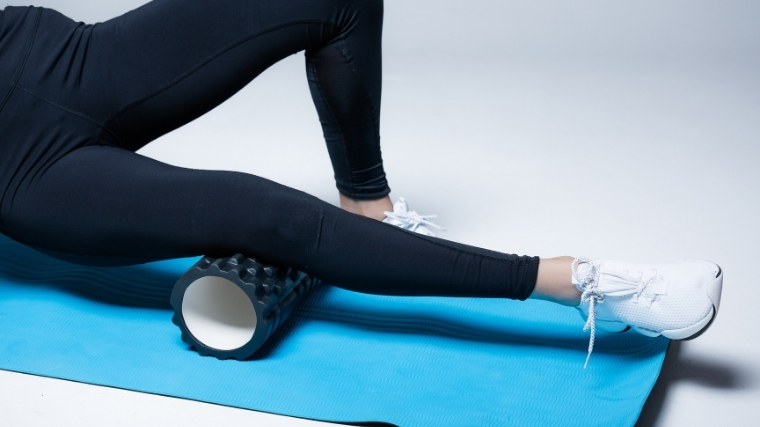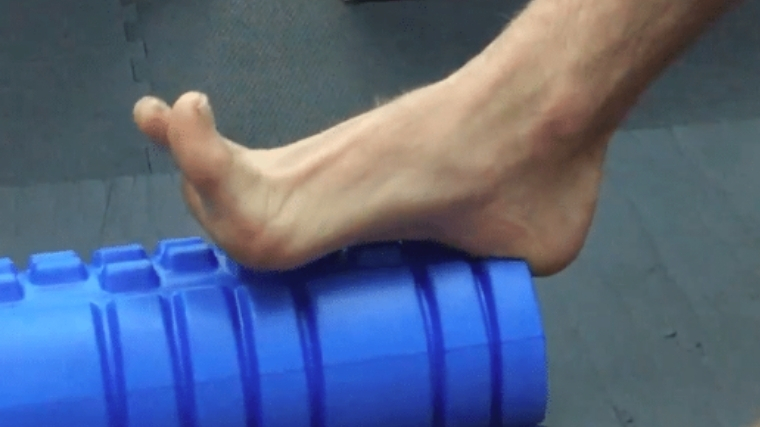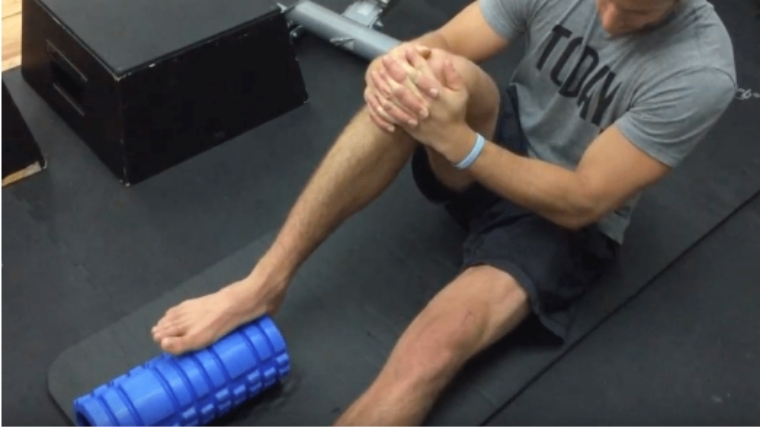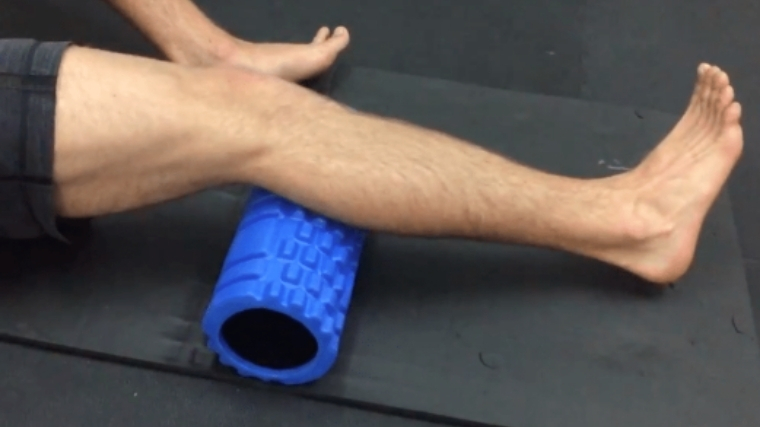Foam rolling is a popular myofascial release method among strength athletes and the general population to help reduce post-exercise muscle soreness and improve mobility. However, outside of just rolling your calves up and down, up and down, finding the best foam roller exercises for the calves is difficult.
That’s partly because the calf is a complex muscle group, more than many people realize. Because foam rolling doesn’t always provide instant benefits, much like anything in the strength training world, it takes time and patience.
So we consulted Matt Moskowitz, Head of Training at Hell’s Kitchen Wellness, to learn about how he approaches foam rolling the calf. Check out the video below, along with more detailed movement descriptions in the article.
Best Foam Roller Calf Exercises
- Restricted Heel Achilles Release
- Achilles Lateral Release
- Long Calf Massage
- Calf Short Head Release
- Roller Restricted Shin Release
Editor’s note: The content on BarBend is meant to be informative in nature, but it shouldn’t take the place of advice and/or supervision from a medical professional. The opinions and articles on this site are not intended for use as diagnosis, prevention, and/or treatment of health problems. Speak with your physician if you have any concerns.
Check Out Our Video Guide
If you’d rather watch than read, the video below delivers plenty of solid information about the same five exercises on this list.
[Related: The 8 Best Leg Exercises for Serious Muscle and Strength]
Restricted Heel Achilles Release
The Achilles is a strong and resilient tendon that accepts and transfers a lot of force during training, but it is often forgotten about when it comes to recovery. Performing this simple release helps with recovery and reduces post exercise soreness after a tough training session.
Benefits of the Restricted Heel Achilles Release
- Restores length and flexibility to the Achilles.
- Helps aid in your recovery after training.
How to Do the Restricted Heel Achilles Release
With the roller facing long-ways with the body, place your heel on the edge of the roller and apply gradual pressure. Point your toes up and flex and release at the ankle to help release the Achilles tendon going up to the calf.
Achilles Lateral Release
The ankle needs stability to resist side to side movement when squatting, deadlifting, and many other leg movements. And rolling this area from side to side helps relax and release your ankle, heel, and Achilles to aid in recovery.
Benefits of the Achilles Lateral Release
- Massages the foot and heel to help release pressure in the achilles.
- It helps to improve your ankle mobility.
How to Do the Achilles Lateral Release
Beginning in the same position as the Restricted Heel Achilles Release, push your heel into the roller, move the foot laterally left to right. Restricting or “cupping” the knee with the hands can help keep the motion under control and prevent the heel from slipping off the roller.
Long Calf Massage
Foam rolling the calf muscles is often neglected because it’s painful. This area often gets tight, sore, and overworked. But excessive soreness and tightness affects ankle mobility and may lead to calf strains if left unchecked. Pay attention to this area by sucking up the momentary pain for long term gain.
Benefits of the Long Calf Massage
- This move helps release tension in the calf muscles, relieve post-exercise soreness, and improves flexibility and range of motion.
- It brings healing blood flow to a much-needed area.
How to Do the Long Calf Massage
Turn the roller horizontally, rolling back and forth over the gastrocnemius (large calf muscle) and keeping the toe pointed toward the sky. Push with your hands behind you and keep your glutes slightly off the ground while rolling back and forth. Applying light to moderate pressure, roll 30 seconds to a minute on each side.
Calf Short Head Release
The calf’s short head release requires a smaller range of motion, around three inches over the calf’s thickest part. Focusing on this after massaging the calf’s long head makes sure you massage and release all of your calf muscles. And be warned, this move doesn’t tickle either.
Benefits of the Calf Short Head Release
- Massages and releases are often neglected where the calf muscles connect with the knee.
- Focuses on the soleus and less on the gastrocnemius.
How to Do the Calf Short Head Release
This is a similar motion to the Long Calf Massage, but with your leg rotated internally towards your other leg. The movement requires a smaller range of motion, around three inches over the calf’s thickest part.
Roller Restricted Shin Release
The anterior tibias’ main function is dorsiflexion (pointing toes up), which plays an important role in ankle mobility and squat and deadlift with good technique. If you lack dorsiflexion, your heels will come off the ground, or you’ll not go through the full range of motion. Both scenarios aren’t ideal. Releasing the anterior tibias prevents this and may play a role in reducing the dreaded shin splints.
Benefits of the Roller Restricted Shin Release
- May reduce your chances of getting shin splints.
- Improves ankle dorsiflexion and overall ankle mobility.
How to Do the Roller Restricted Shin Release
Begin on your hands and knees and bring one knee up partway towards your chest and place the roller under their shin. Applying light pressure while flexing and extending the toes towards and away from your body for 20 reps.
Moskowitz recommends doing this in five different “sections” up and down the front of the leg to target the whole shin. He recommends this be performed on a softer roller if any discomfort occurs with a firmer or standard foam roller, as the front of the shin can be more sensitive.
All About the Calves
Your calf muscles move you forward, backward, and side to side. With every step you take, they absorb the load impact of your body, whether you’re running, jumping, or training legs. Plus, they provide support for your lower body, and if they’re restricted, it may affect the mobility and stability of the joints further up the body.
By spending time massaging and releasing the calf area, you’ll have better ankle movement for your squats and deadlifts and allow the ankle to do its job better when you’re running, jumping, skipping, or walking.
Anatomy of the Calves
The calf has a few muscles, some that are not seen or sometimes neglected. Understanding what the calf muscles are and how they work is important when massaging and releasing your calves.
Gastrocnemius
This is the larger visible calf muscle, forming the bulge beneath the skin. The gastrocnemius is a two-part muscle that together creates its diamond shape. It originates from the femur underneath the knee and inserts on the heel via the Achilles tendon. Its main function is foot plantar flexion (heel coming off the ground), but it also assists in knee flexion.
Soleus
This the smaller, flat muscle that lies directly underneath the gastrocnemius muscle, and it’s not really visible to the naked eye. It originates from the tibia and fibula below the knee and inserts on the heel via the Achilles Tendon. Its function is foot plantar flexion, but because it only crosses at the heel joint, the best way to train the muscle is with the knees bent.
Plantaris
This long, thin muscle extends behind the knee, where it forms together with the gastrocnemius and soleus. It originates from the lateral femur and inserts of the posterior of the hell via the Achilles tendon. Its function is foot plantar flexion, but because it crosses two joints, it also assists in knee flexion.
Anterior Tibias
The anterior tibias sits at the front of the leg that dorsiflexes the ankle (pointing toes towards you) and inverts the ankle (tilting of the sole of the foot towards the midline). It originates along the upper two-thirds of the tibia’s outside surface and inserts into the metatarsal bones that connect your ankle to your toes.
The Benefits of Massaging and Releasing The Calf Muscles
The calves and the Achilles tendon absorb (up to 10 times our body weight) and repeatedly produce force whether we’re lifting, running, jumping, or even walking. They often need special attention to help recover and restore range of motion and reduce post-training soreness. Here are the benefits of focusing on this important area.

Reduce Muscle Adhesions (Trigger points)
Foam rolling and releasing your calves may help reduce trigger points created as the result of collagen binding between layers of muscle. This restricts the ability to move, reducing mobility and increasing your chances of pain.
Helps To Reduce Tension And Tightness
Following on from the point above, foam rolling your calf can reduce tension and muscle tightness to restore and improve the ankle range of motion. Regular foam rolling of this area may reduce muscle tightness, ensuring good ankle mobility optimal and improving your lower body movement.
Reduce Post Training Soreness
Massaging and releasing the calf complex after training may reduce training soreness and enhance the recovery process. After training, massaging can help minimize the risk of the new collagen forming adhesions (trigger points) between layers of muscle. Plus, the pressure of the roller helps increase blood flow, further promoting recovery.
More Calf Foam Rolling Tips
Foam rolling is an important tool in an athlete’s arsenal of recovery and mobility toolbox. Still, it doesn’t always work immediately — especially when rolling the calves and other parts of the lower body. Results may take weeks of gradual work to release tight muscles.
Now that you have a handle on the best foam rolling exercise to improve ankle movement, you can also check out these other helpful foam rolling articles for strength, power, and fitness athletes.
Featured image: DmitryStock/Shutterstock




